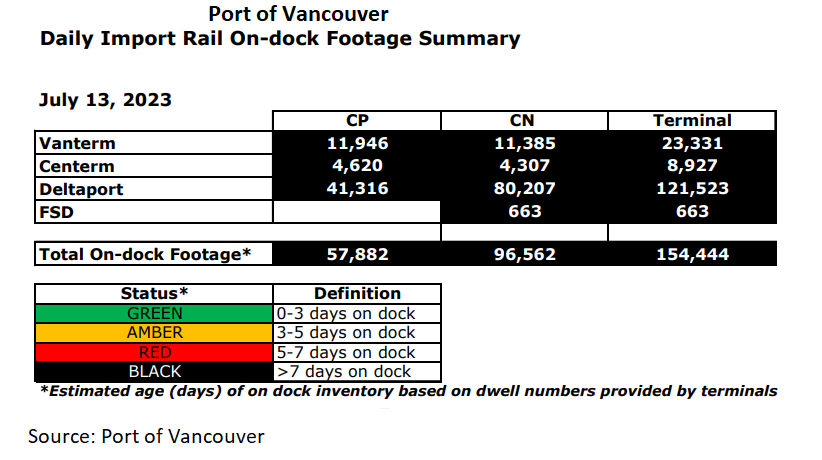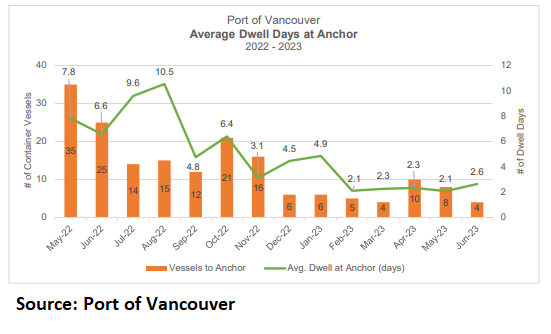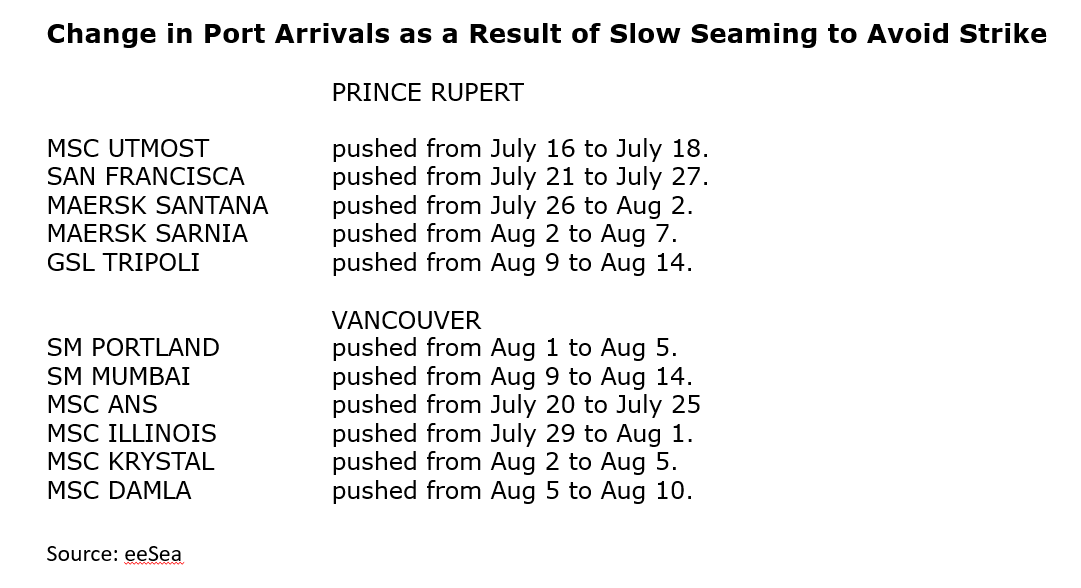Freight News:
Viewpoint: Impact of Canada ports strike to be felt for weeks
For some Americans, the International Longshore and Warehouse Union ports strike in Canada never made it on their radar. But while Canada will feel the impact far more than the United States, that does not mean we got away squeaky clean.
The impact of the container reconsignments and vessel diversions we saw during the past 13 days will come with extra costs. Thankfully, the U.S. West Coast ports have more open capacity to receive goods, so congestion should not be an issue.
Rail customers will be faced with more moves based on the difference in rail connectivity between the U.S. and Canada, and container delays from a U.S. port standpoint will not be bad. The box will be more expensive considering shippers would have to pay the extra costs for customs, port fees, etc.
The fallout of this strike is centralized around the Canadian rail system. Considering 15% of U.S. trade arrives into the Port of Vancouver and 60% of all rail out of the Port of Prince Rupert is destined for the U.S., this is something we should be concerned about. Here’s why: The congestion is going to bleed into peak season. The Railway Association of Canada estimates one day of strike equals to three to five days of clearing up. This strike was 13 days, meaning the rail congestion alone could be between 39 and 65 days. Yep, you read that right.
Being a data lover, I was excited on Wednesday to get the Association of American Railroads data so I could look at the trade from Canada arriving into the U.S. I knew it was going to be bad, but just how bad it was for one week shows you for what’s to come. The AAR reported a 46% drop in freight rail traffic entering the U.S. from Canada over the past week as a result of the strike.
The top sectors impacted chemicals, including oil and petroleum products, nonmetallic minerals such as crushed stone, sand, stone, clay and glass products, and forest products such as lumber and wood products. The National Association of Chemical Distributors said millions of dollars of chemicals that go into paints, coatings and acids from Asia are stuck on vessels.
“Many of our members are rebooking through U.S. West Coast ports with the likelihood of an extra 10-14 days of ground transit time because of the redirect,” said Eric Byer, CEO of the National Association of Chemical Distributors. “Some member company products have been on the water since June 30, and other arrivals earlier this month are now not being slated to be unloaded until early to mid-August at the earliest.”
Also on the rails: apparel, footwear, back-to-school items and holiday products.
The delays on the rails will be evident again in next week’s data. With volumes down almost 50% this week, you can expect a similar wallop.
So now that the ILWU is back to work and the plug that was stopping trade has been pulled, we need to look at the congestion that grew over this time. It’s a tangled mess for sure.
Here’s what’s on dock at midday Friday at the Port of Vancouver. This is before any additional containers are unloaded from waiting vessels.

These are containers filled with items that should have been well on their way by now.
In a statement to American Shipper on Friday, the Port of Vancouver/VancouverFraser Port Authority said: “It is too early for us to say how long it may take to fully recover from the disruptions. Our focus right now is on working with government agencies and industry partners, including shipping and rail companies, as well as marine terminals to implement recovery plans and restore full port operations and fluidity.
“The port authority will apply a priority-based anchorage allocation system to balance the needs of all business sectors and commodities. Recovery measures include close collaboration and monitoring to ensure port resources are assigned to best support time-sensitive cargo movement and ensure equitable distribution of shared resources.”
Paul Brashier, vice president of drayage and intermodal at ITS Logistics, told American Shipper that while he is happy the strike is over, unfortunately, the difficult work now begins.
“There are two weeks of containers needing to be removed from the terminals, which will take four weeks at best,” he explained. “There then will be rail ramp challenges in Chicago and the Midwest as a large share of the containers entering western Canada are routed there for U.S. consumption. That will add another two to four weeks of disruption.”
Brashier said he is calling on the terminal and rail ramp operators to immediately review ramp storage and demurrage policies.
“Shippers and truckers need to be protected from these fees,” he stressed. “These delays are the result of the inability of labor and management to reach a deal. That caused this disruption.”

The clog that will delay both truck and rail containers out of Canada is created by the vessels waiting to get in. Prior to the strike, the number of days a vessel spent offshore at Vancouver was around one or two. This was off the highs seen in April, when it was recorded at around 5.5 days. The average dwell at anchor for a vessel typically is 2.6 days.
According to vessel tracking company eeSea, the Port of Vancouver is experiencing 100% congestion. Eight vessels were waiting to berth, 12 were slow steaming and none were at port. Four vessels came back after pulling up anchor during the strike and diverted to U.S. ports.
The Port of Prince Rupert, where 60% of U.S. rail originates, is also at 100% congestion, with five vessels waiting and five slow steaming. Based on the port’s intermodal data, the port sees four vessel calls a week.
Port omissions/slow steaming
While some ocean carriers started to omit the ports of Vancouver and Prince Rupert for future sailings, others took the slow-as-you-go approach. Ocean carriers hoped by the time the vessels arrived, the strike would be over and the initial vessel congestion shock would be lessening.

“For the immediate backlog at Prince Rupert and Vancouver, we expect to see a minimum average delay of 2.5 to three days before they are able to berth, and that may be an optimistic outlook,” explained Destine Ozuygur, head of operations at eeSea. “Regarding delays affecting expected monthly volume, we have already seen eight vessels pushed into August and seven into September. Our analysts expect that number to rise by three or four more.”
We saw the water chess game moves in real time for the last 13 days. During this time, eeSea’s final tally was 10 port swaps and six diversions. While some of that maneuvering helped, it was not a remedy.
“While it remains to be seen whether or not there will be more port omissions of the Canadian ports in the tail end of next month or even into September, it certainly isn’t out of the question,” Ozuygur said.
About $605 million in trade moves through one of those two ports daily, according to the Canadian Chamber of Commerce. Approximately $572 million in container trade arrives daily to the U.S. from Canada, according to a breakout of U.S. Census data. This is no chump change.
Steve Lamar, CEO of the American Apparel and Footwear Association, told American Shipper that it’s going to take a while to fully unwind the backups as a result of the strike.
“Our best guess [is] six to eight weeks for full normalization,” he said. “That said, we are hearing from some members that they could be back to normal within a week to 10 days.”
Lamar added, “In the long term, the British Columbia strike and the brinkmanship and uncertainty surrounding the U.S. West Coast ports talks have fueled sustained interest in developing alternative logistics routes. All eyes are now on the East and Gulf Coast ports, which picked up a lot of diversion business in the past year, to see if they can avoid disruptions and quickly reach a long-term renewal of that contract before it expires next year.”
So the summer of strikes and labor tussles will continue. This dumpster fire may be out, but the stench it created will linger for months. Now logistics managers can cross off one strike on their calendars.
Time to focus on the other looming potential strikes.
The post Viewpoint: Impact of Canada ports strike to be felt for weeks appeared first on FreightWaves.
Source: freightwaves - Viewpoint: Impact of Canada ports strike to be felt for weeks
Editor: Lori Ann LaRocco